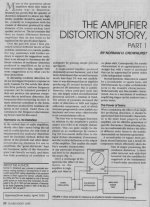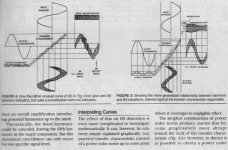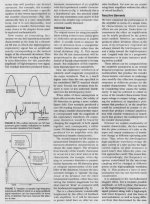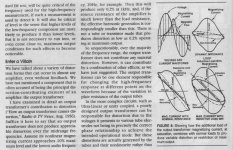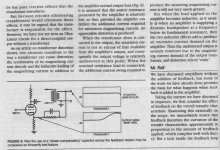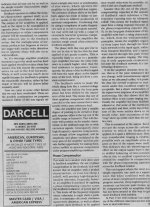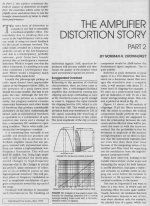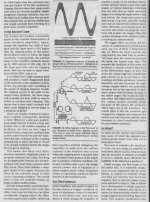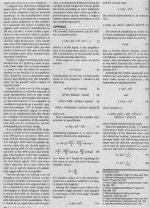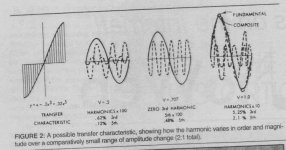I found an old article, by Norman H. Crowhurst originally in Audio magazine may 1959, title " The amplifier distortion story", re-printed in Glass Audio volume 7 no.6 1995.
He based his writings on tubes.
Anyone can translate how would his writings like if "tubes" are replaced with "transistors"?
He based his writings on tubes.
Anyone can translate how would his writings like if "tubes" are replaced with "transistors"?
Hi,
If I remember correctly that is the article that states THD (total
harmonic distortion) (+noise) as a figure is entirely misleading.
He suggested harmonics should be weighted logarithmically.
The most common accepted form is by (n sqared) over 4.
That leaves second harmonic as its real value, 3rd = x 2.25,
4th = x 4, 5th = x 6.25, 6th = x 9, 7th = x 12.25, 8th = x 16 etc.
This has serious repercussions for standard solid state amplifiers.
They routinely produce harmonics at least up to the 20th (x100)
for 1kHz crossover distortion, and due to the nature of standard
feedback the higher harmonics are emphasised, they double in
level for each octave.
Not surprisingly with the advent of the new fangled transistors
giving power amplifiers with lower THD+N than valve amplifiers
the significance of such work was quietly ignored.
The claim is his work only applied to the first few harmonics
of valve amplifier distortion, and cannot be applied to the
crossover distortion of transistor power amplifiers.
Me, I think it can, and does apply to transistor power amplifiers.
 , sreten.
, sreten.
If I remember correctly that is the article that states THD (total
harmonic distortion) (+noise) as a figure is entirely misleading.
He suggested harmonics should be weighted logarithmically.
The most common accepted form is by (n sqared) over 4.
That leaves second harmonic as its real value, 3rd = x 2.25,
4th = x 4, 5th = x 6.25, 6th = x 9, 7th = x 12.25, 8th = x 16 etc.
This has serious repercussions for standard solid state amplifiers.
They routinely produce harmonics at least up to the 20th (x100)
for 1kHz crossover distortion, and due to the nature of standard
feedback the higher harmonics are emphasised, they double in
level for each octave.
Not surprisingly with the advent of the new fangled transistors
giving power amplifiers with lower THD+N than valve amplifiers
the significance of such work was quietly ignored.
The claim is his work only applied to the first few harmonics
of valve amplifier distortion, and cannot be applied to the
crossover distortion of transistor power amplifiers.
Me, I think it can, and does apply to transistor power amplifiers.
Well now I've seen that abstract I would have to agree with sreten. The higher the order of harmonic the worse the shape of the in/out curve is along it's whole length which says more about linearity range. A more simple deflection of the in/out curve would yield a lower order but possibly higher level (which seems to be more benign) distortion. So it seems fair to say higher harmonics are worse and weight them accordingly.
Distortion and harmonics are the same evil whether the amplifying device is valve or solid state.
Distortion and harmonics are the same evil whether the amplifying device is valve or solid state.
- 2 stages of single ended (assuming each only produces 2nd harmonic) will produce higher order harmonics.
- A system producing 9th harmonic if subjected to feedback will produce 81st harmonic.
- 5% of 2nd harmonic is not audible, but an amp that produces 5% 2nd harmonic will also make IM which is audible
- What are the 3 things that the author mentioned in pages 8,9,10?
Is this why simple amps tends to sound better?
What amazed me most, this article is written in 1959. If I dont see the 1959 digit, I will tought that it is written by someone in 2006
- A system producing 9th harmonic if subjected to feedback will produce 81st harmonic.
- 5% of 2nd harmonic is not audible, but an amp that produces 5% 2nd harmonic will also make IM which is audible
- What are the 3 things that the author mentioned in pages 8,9,10?
Is this why simple amps tends to sound better?
What amazed me most, this article is written in 1959. If I dont see the 1959 digit, I will tought that it is written by someone in 2006
Thank you too, David, I agree with Jacco.
I've seen this before, years back, but, together with modern theories of psychoacoustics and transfer functions, it certainly fits well with observed amplifier characteristics.
Simpler amp - less IM products - curved, but not stepped, transfer function - better sound.
Cheers,
Hugh
I've seen this before, years back, but, together with modern theories of psychoacoustics and transfer functions, it certainly fits well with observed amplifier characteristics.
Simpler amp - less IM products - curved, but not stepped, transfer function - better sound.
Cheers,
Hugh
Jacco, AKSA, you're all welcome 
Fig 9 and 12. Crowhurst looks at voltage at different point of amplifier. It is very interesting about clipping. When the output node is clipping even slightly, in nodes in amplifier there will occur "blips" that is much higher than the inverse of clipped output. Also about square waves. When an amplifier is optimised for square wave at output node, at nodes inside the cct will occur ugly signals.
Maybe it is better to leave the square test "not perfect" rather than having clipped transients inside the cct? These transients will be magnified IM.
Fig 9 and 12. Crowhurst looks at voltage at different point of amplifier. It is very interesting about clipping. When the output node is clipping even slightly, in nodes in amplifier there will occur "blips" that is much higher than the inverse of clipped output. Also about square waves. When an amplifier is optimised for square wave at output node, at nodes inside the cct will occur ugly signals.
Maybe it is better to leave the square test "not perfect" rather than having clipped transients inside the cct? These transients will be magnified IM.
- Status
- This old topic is closed. If you want to reopen this topic, contact a moderator using the "Report Post" button.
- Home
- Amplifiers
- Solid State
- Translation needed
